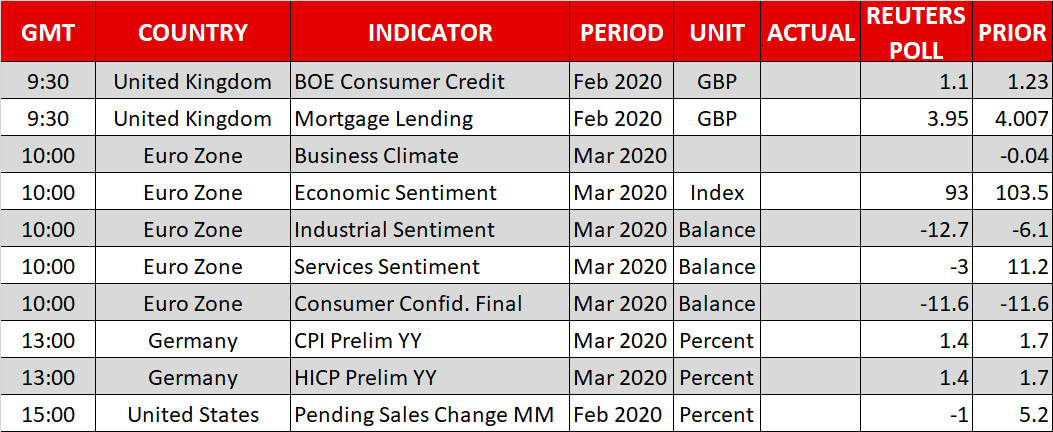Daily Market Comment – Dollar edges up, stocks muted in cautious start to week
- Stocks steady somewhat after Friday’s dip
- Dollar heads higher after worst week since 2009
- Oil skids again; Brent hits 17-year low as world economy shuts down
 US stock futures attempt to rebound; risk of increased volatility
US stock futures attempt to rebound; risk of increased volatilityWall Street was unable to extend its winning streak to a fourth day on Friday but still managed to post its strongest week since 2009. Stocks had been steadily rising after a big gap lower at the open but went into reverse after the Federal Reserve said it will rein in its daily purchases of Treasuries to $60 billion from April 2, highlighting how jittery markets still are about possible liquidity shortfalls.
However, it was a somewhat calmer picture today, with US and European stock futures inching higher at one point and helping Asian shares to pare some of their losses. Sentiment remains fragile despite a plethora of stimulus being announced by central banks and governments in recent weeks and today’s bullish efforts could be down to month-end and quarter-end flows as investors adjust their portfolio holdings.
But this also raises the prospect of increased volatility in the next couple of days as the combination of dealers having to execute large volumes of trades from their homes may pose operational constraints. And then there is the liquidity concern as the huge flows may generate a fresh dollar squeeze.
Dollar recovers from 2-week lowThe possibility of markets being hit by another round of dollar shortages would undoubtedly bring more pain for emerging market and risk-sensitive currencies and there is already evidence of this at the start of the week’s trading. The Mexican peso and South African rand are down 1.7% and 2.2% respectively, while the aussie and kiwi were last trading down by 0.7% and 0.6% respectively, ending last week’s incredible rally.
The euro and the pound were also struggling, with the euro slipping back below the $1.11 level and the pound dropping below $1.24. The declines could be a technical correction after gaining sharply over the past week as central bank action helped ease the dash for cash, with month-end flows amplifying the moves.
However, Europe remains a major concern for investors as the COVID-19 pandemic shows no sign of slowing. Health services across the region are at breaking point, particularly in Italy, Spain, France and the United Kingdom where the death rate has soared in recent days and key government figures in Britain have tested positive for the coronavirus, including the prime minister.
In contrast, the death rate in the United States is relatively low despite the country now being officially the epicentre of the disease as the jump in the number of cases there is mainly due to an increase in the number of tests being carried out.
Investors might therefore see the US as being better placed to recover from the crisis, especially after Congress passed a $2.2 trillion stimulus bill and there is now talk of a fourth virus relief package. The US dollar was last up 0.6% versus a basket of currencies, halting a week-long slide, while against the yen, it climbed back above the 108 level.
The safe havens yen and gold were both struggling on Monday even though risk appetite was scarce.
Oil slumps again as lockdowns are here to stayOil prices tumbled on Monday, extending last week’s losses as the prospect of a quick end to the crisis continued to diminish. Many countries have imposed strict lockdowns on their citizens in a bid to contain the spread of the virus and tougher measures could yet be imposed in some places if existing policies don’t work.
The lockdowns look set to last at least until the end of April, with President Trump just announcing that the guidelines on social distancing will be extended to April 30. In the UK, officials have warned that it could be six months before life returns to normal, even as many businesses in China reopen for the first time in weeks.
The timescale of the shutdowns is a major source of uncertainty for businesses and for investors, as until there is some clarity on how long these restrictions will stay in place, there’s unlikely to be a convincing turnaround in market sentiment.
This has left commodities such as oil, which have been hurt the most by the collapse in demand, running for cover. Brent crude plummeted by 7.5% to $23.07 a barrel - the lowest in 17 years – while WTI was down 5.2% to $20.40 a barrel.

免責聲明: XM Group提供線上交易平台的登入和執行服務,允許個人查看和/或使用網站所提供的內容,但不進行任何更改或擴展其服務和訪問權限,並受以下條款與條例約束:(i)條款與條例;(ii)風險提示;(iii)完全免責聲明。網站內部所提供的所有資訊,僅限於一般資訊用途。請注意,我們所有的線上交易平台內容並不構成,也不被視為進入金融市場交易的邀約或邀請 。金融市場交易會對您的投資帶來重大風險。
所有缐上交易平台所發佈的資料,僅適用於教育/資訊類用途,不包含也不應被視爲適用於金融、投資稅或交易相關諮詢和建議,或是交易價格紀錄,或是任何金融商品或非應邀途徑的金融相關優惠的交易邀約或邀請。
本網站的所有XM和第三方所提供的内容,包括意見、新聞、研究、分析、價格其他資訊和第三方網站鏈接,皆爲‘按原狀’,並作爲一般市場評論所提供,而非投資建議。請理解和接受,所有被歸類為投資研究範圍的相關内容,並非爲了促進投資研究獨立性,而根據法律要求所編寫,而是被視爲符合營銷傳播相關法律與法規所編寫的内容。請確保您已詳讀並完全理解我們的非獨立投資研究提示和風險提示資訊,相關詳情請點擊 這裡查看。
